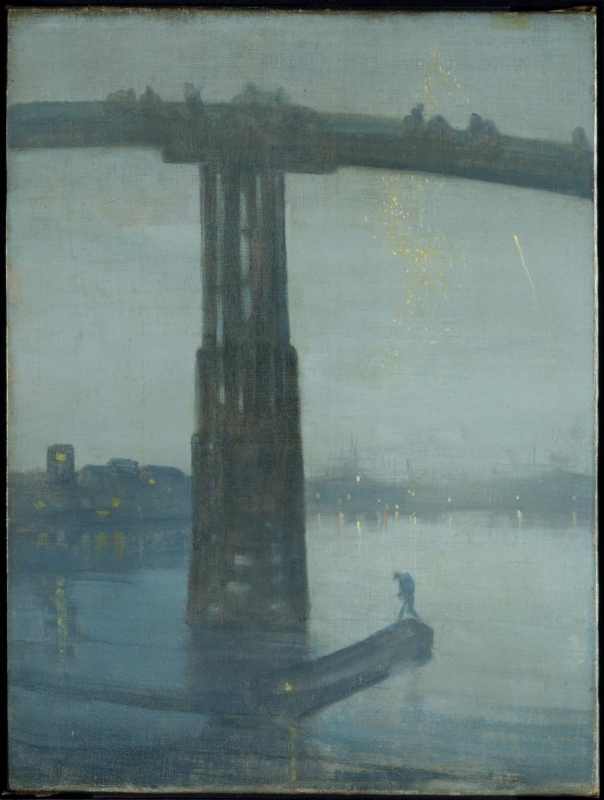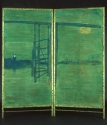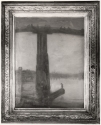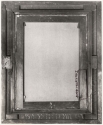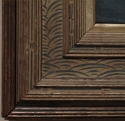Home > Catalogue > Browse > Nocturne: Blue and Gold – Old Battersea Bridge << >>
Composition
Whistler made numerous drawings and pastels of the bridge, such as the recto of r.: Nocturne: Battersea Bridge; v.: Standing Female Nude [M.0484]. However, most of these are studies for Blue and Silver: Screen, with Old Battersea Bridge [YMSM 139], which is closely related in composition to this oil painting.
Technique
A detailed report by Professor Joyce H. Townsend provides both information and analysis of the technique, condition and conservation of the painting:
'There is tantalising evidence for up to three earlier images, now scraped down. A transmitted infrared image (not illustrated) suggests that the canvas had an earlier use in the same orientation, for a face that filled most of its area; the X-radiograph does not show this at all clearly although it does suggest the same earlier image. The paint is (collectively) untypically thick despite the thinness of the final image, so X-radiography had to be done using a higher voltage than is usually necessary. The X-radiograph suggests another image upside-down on the canvas: a half-length figure possibly with a palette on the lap, probably dark-haired, since the plentiful cloud of hair includes very little lead white, the pigment that makes the technique of X-radiography so useful for rendering earlier images. This could have been a Whistler self-portrait. It also suggests an earlier composition with the left side of the bridge possibly on land at the bottom of the image, with some figures extending about halfway up the canvas. This image was the most severely rubbed down. The sequence of painting these earlier images cannot be determined with X-radiography.
The canvas is quite fine, with slubs (thicker threads of uneven width), and knots that can be seen where Whistler rubbed the paint down to the tops of the canvas threads. It has an off-white commercial priming made from two layers of lead white in oil upon a glue-sized canvas, to which he applied a mid-toned pinkish brown imprimatura containing mainly lead white and lamp black, giving it a warmer tone than the bone black he often employed, in oil medium. Its perceived pinkish colour, visible where it composes the shore line, is an effect of juxtaposition against the blue tones surrounding it.
Cusping can be seen only on the top edges, indicating the original points of attachment of the canvas to a larger stretcher. The absence of cusping on the other three sides indicate a loss of at least 10-15 mm on the other three sides, when the canvas was attached to the present stretcher.
The imprimatura was utilised for the distant shore, by not covering it with blue paint. The sequence of painting involved applying localised white paint for the first planned positions of the fireworks, then thinned blue paint for the water and the sky, with several attempts rubbed down, sometimes to the canvas tops, on many occasions revealing the brown imprimatura or the white priming. The span of the bridge was painted next. It is not clear if this area had only imprimatura up till then, or was painted blue. The pier of the bridge was clearly applied over the water, and by the time the pier was painted, the water coming up to the line of the shore was already drying. Whistler then altered it close to the bridge pier, and today this area has fine cracking in consequence. The sky seen through the bridge struts was applied over them, and the lights and their reflections were placed at the same time. The boatman was added very late, and this area has a localised and unique pattern of cracking. The multiple modification of the fireworks occurred at a late stage as well. The most prominent rocket was applied to still-wet paint, which was then partly wiped way to create a diminishing trail of paint for its tail. The paint in this topmost image is very thin and was also highly thinned, with added medium modifier to maintain gloss and to reduce dripping down the canvas. Its fluorescence in ultraviolet light, tendency to soften when slightly heated, and high refractive index, all suggest a medium modifier based on natural resins, as well as oil tube paint and turpentine.
All the blue paint contains lead white and Prussian blue, toned with lamp black and brown ochre, not bone black, as well as madder and another red lake pigment. The bridge and the smoke in the sky were also painted with brown, not black, pigments. The fireworks include lead white, mars orange (a brightly-coloured synthetic iron oxide), red mixed with white for the pink tones, and a bright yellow that was not identified.
There are some retouches in the area of sky with the rockets, at top right. Clearly paint has flaked in this area, and the X-radiograph makes it clear that Whistler removed some rockets and added others, by scraping and re-applying paint. If the surface were already drying, flaking would be expected. Below the bridge, in two areas where Whistler’s abrasion was severe, there are two blocks of retouching. The upper edge has the remains of a resinous varnish (though it is not clear from which of the several images), and the tower has tended to absorb paint medium.' 1
Conservation History
Professor Townsend also discussed the later conservation of the painting:
'In 1942 the painting had been removed from London during World War II, and it was treated at Glasgow Museums by National Gallery restorer Helmut Ruhemann, who lined the canvas using wax/resin adhesive (or sent it out for lining, as was common at the time), removed a yellowed and tinted varnish, and retouched some areas, presumably after applying the ‘varnish’ of ‘wax and carnauba cream only’ which he noted. His notes imply that this was the first occasion when the canvas was lined. Since the original stretcher is not in use now, he must have replaced it. A fine-scale crack pattern suggests that the original stretching was uneven, the canvas threads having been pulled down at the bottom right corner. Wax lining tends to modify the texture and gloss of the paint surface less than did the glue-based linings and natural resin varnishes applied to many of Whistler’s works in his own lifetime or shortly afterwards, and Ruhemann likely took a cautious approach to varnish removal too.'
Little original or early varnish remains, the present varnish being a synthetic resin. Hence there is little discolouration from the yellowed varnishes that are seen on some other nocturnes, and the tonality is close to Whistler’s intention. This painting has had fewer conservation treatments and varnish removals than many, and on the surface there are traces of a proteinaceous layer that might be a temporary egg white varnish applied by Whistler soon after painting. He appears to have used this on a number of sketches on panel in mid and later life, possibly to fix drawing in charcoal or even flaking paint. Typical cycles of varnish removal in the earlier twentieth century would have removed such evidence. The light wax coating that protects the surface today fulfils a similar protective function to an egg white varnish, without unduly saturating the colours, and may well be presenting a good impression of the surface as seen when Whistler first displayed this painting.' 2
Frame
Description: Flat Whistler frame, painted seigaiha and butterfly. Support: 68.3 x 51.2 cm; frame: 92.2 x 76.0 x 8.3 cm.
History: 1876/1878: Flat Whistler frame made by Foord & Dickinson: gold leaf (oil gilding) on wood (oak on pine) painted with seigaiha pattern and butterfly signature. 3
The oil paint of the seigaiha (blue sea wave) pattern has been applied more delicately and fluidly than on the Tate’s earlier Nocturne: Blue and Silver - Chelsea [YMSM 103]. It is also present on both the frieze and two fillets. There is a butterfly signature located at the mid-right rail.
1878: The picture was displayed in 'a small retrospective' during the Whistler v. Ruskin trial in November 1878, when Whistler hoped it would ‘vindicate his position as an established accomplished artist.' 4 During the trial, Whistler said:
'The blue colouring on the gilt frame is part of the scheme of the picture. The blue spot on the right side of the frame is my monogram, which I place on the frame as well as the canvas; it balances the picture. The frame and the picture together are a work of art.' 5
1905: The glazed outer-frame was fitted around the time of accession by the Tate in 1905 to protect the painting and frame’s surface.
Last updated: 8th June 2021 by Margaret

